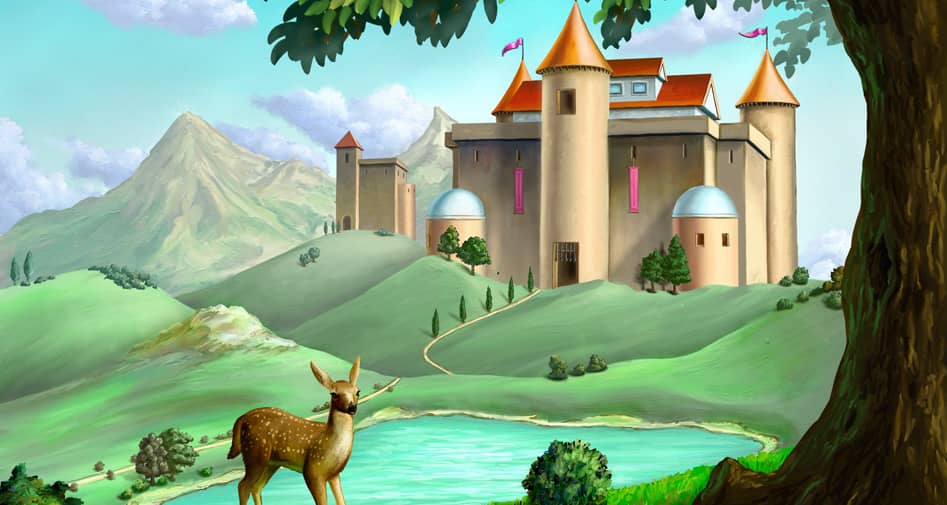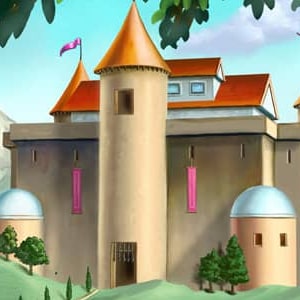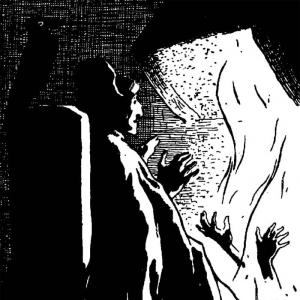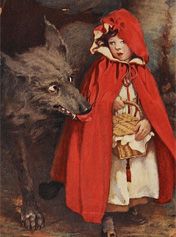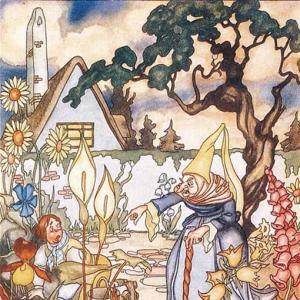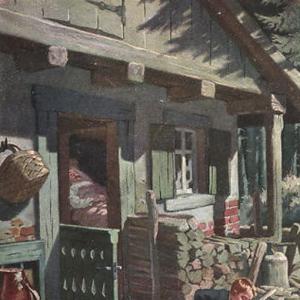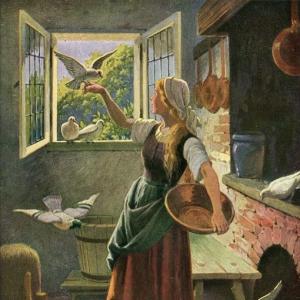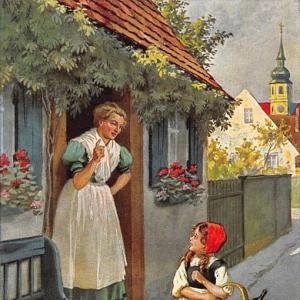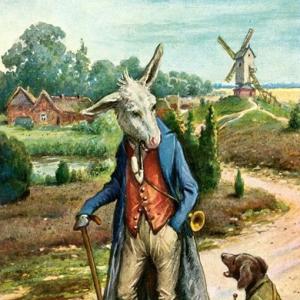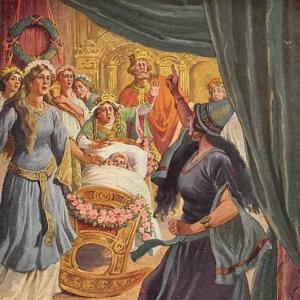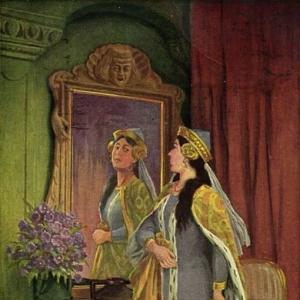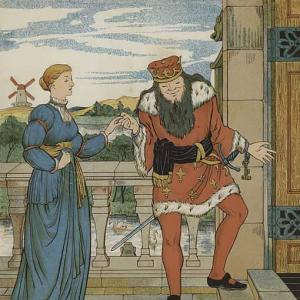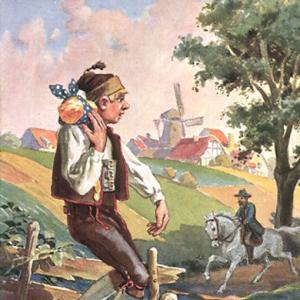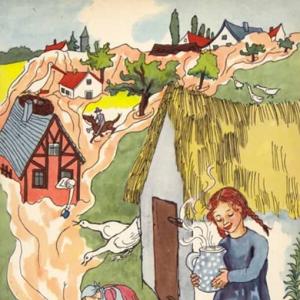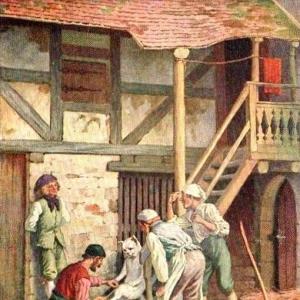Reading time for children: 12 min
Yes, they called him Little Tuk, but it was not his real name. He had called himself so before he could speak plainly, and he meant it for Charles. It was all very well for those who knew him, but not for strangers.
Little Tuk was left at home to take care of his little sister, Gustava, who was much younger than himself, and he had to learn his lessons at the same time, and the two things could not very well be performed together. The poor boy sat there with his sister on his lap, and sung to her all the songs he knew, and now and then he looked into his geography lesson that lay open before him. By the next morning he had to learn by heart all the towns in Zealand, and all that could be described of them.
His mother came home at last, and took little Gustava in her arms. Then Tuk ran to the window, and read so eagerly that he nearly read his eyes out. For it had become darker and darker every minute, and his mother had no money to buy a light.
„There goes the old washerwoman up the lane,“ said the mother, as she looked out of the window; „the poor woman can hardly drag herself along, and now she had to drag a pail of water from the well. Be a good boy, Tuk, and run across and help the old woman, won’t you?“
So Tuk ran across quickly, and helped her, but when he came back into the room it was quite dark, and there was not a word said about a light, so he was obliged to go to bed on his little truckle bedstead, and there he lay and thought of his geography lesson, and of Zealand, and of all the master had told him. He ought really to have read it over again, but he could not for want of light. So he put the geography book under his pillow, for he had heard that this was a great help towards learning a lesson, but not always to be depended upon. He still lay thinking and thinking, when all at once it seemed as if some one kissed him on his eyes and mouth. He slept and yet he did not sleep; and it appeared as if the old washerwoman looked at him with kind eyes and said, „It would be a great pity if you did not know your lesson to-morrow morning. You helped me, and now I will help you, and Providence will always keep those who help themselves;“ and at the same time the book under Tuk’s pillow began to move about. „Cluck, cluck, cluck,“ cried a hen as she crept towards him. „I am a hen from Kjoge,“ and then she told him how many inhabitants the town contained, and about a battle that had been fought there, which really was not worth speaking of.
„Crack, crack,“ down fell something. It was a wooden bird, the parrot which is used as a target as Prastoe. He said there were as many inhabitants in that town as he had nails in his body. He was very proud, and said, „Thorwaldsen lived close to me, and here I am now, quite comfortable.“
But now little Tuk was no longer in bed; all in a moment he found himself on horseback. Gallop, gallop, away he went, seated in front of a richly-attired knight, with a waving plume, who held him on the saddle, and so they rode through the wood by the old town of Wordingburg, which was very large and busy. The king’s castle was surrounded by lofty towers, and radiant light streamed from all the windows. Within there were songs and dancing; King Waldemar and the young gayly-dressed ladies of the court were dancing together. Morning dawned, and as the sun rose, the whole city and the king’s castle sank suddenly down together. One tower after another fell, till at last only one remained standing on the hill where the castle had formerly been.
The town now appeared small and poor, and the school-boys read in their books, which they carried under their arms, that it contained two thousand inhabitants; but this was a mere boast, for it did not contain so many.
And again little Tuk lay in his bed, scarcely knowing whether he was dreaming or not, for some one stood by him.
„Tuk! little Tuk!“ said a voice. It was a very little person who spoke. He was dressed as a sailor, and looked small enough to be a middy, but he was not one. „I bring you many greetings from Corsor. It is a rising town, full of life. It has steamships and mail-coaches. In times past they used to call it ugly, but that is no longer true. I lie on the sea-shore,“ said Corsor; „I have high-roads and pleasure-gardens. I have given birth to a poet who was witty and entertaining, which they are not all. I once wanted to fit out a ship to sail round the world, but I did not accomplish it, though most likely I might have done so. But I am fragrant with perfume, for close to my gates most lovely roses bloom.“
Then before the eyes of little Tuk appeared a confusion of colors, red and green; but it cleared off, and he could distinguish a cliff close to the bay, the slopes of which were quite overgrown with verdure, and on its summit stood a fine old church with pointed towers. Springs of water flowed out of the cliff in thick waterspouts, so that there was a continual splashing. Close by sat an old king with a golden crown on his white head. This was King Hroar of the Springs and near the springs stood the town of Roeskilde, as it is called. Then all the kings and queens of Denmark went up the ascent to the old church, hand in hand, with golden crowns on their heads, while the organ played and the fountains sent forth jets of water.
Little Tuk saw and heard it all. „Don’t forget the names of these towns,“ said King Hroar.
All at once everything vanished; but where! It seemed to him like turning over the leaves of a book. And now there stood before him an old peasant woman, who had come from Soroe where the grass grows in the market-place. She had a green linen apron thrown over her head and shoulders, and it was quite wet, as if it had been raining heavily. „Yes, that it has,“ said she, and then, just as she was going to tell him a great many pretty stories from Holberg’s comedies, and about Waldemar and Absalom, she suddenly shrunk up together, and wagged her head as if she were a frog about to spring. „Croak,“ she cried; „it is always wet, and as quiet as death in Soroe.“ Then little Tuk saw she was changed into a frog. „Croak,“ and again she was an old woman. „One must dress according to the weather,“ said she. „It is wet, and my town is just like a bottle. By the cork we must go in, and by the cork we must come out again. In olden times I had beautiful fish, and now I have fresh, rosy-cheeked boys in the bottom of the bottle, and they learn wisdom, Hebrew and Greek.“
„Croak.“ How it sounded like the cry of the frogs on the moor, or like the creaking of great boots when some one is marching,– always the same tone, so monotonous and wearing, that little Tuk at length fell fast asleep, and then the sound could not annoy him. But even in this sleep came a dream or something like it. His little sister Gustava, with her blue eyes, and fair curly hair, had grown up a beautiful maiden all at once, and without having wings she could fly. And they flew together over Zealand, over green forests and blue lakes.
„Hark, so you hear the cock crow, little Tuk. ‚Cock-a-doodle-doo.‘ The fowls are flying out of Kjoge. You shall have a large farm-yard. You shall never suffer hunger or want. The bird of good omen shall be yours, and you shall become a rich and happy man; your house shall rise up like King Waldemar’s towers, and shall be richly adorned with marble statues, like those at Prastoe. Understand me well; your name shall travel with fame round the world like the ship that was to sail from Corsor, and at Roeskilde,– Don’t forget the names of the towns, as King Hroar said,– you shall speak well and clearly little Tuk, and when at last you lie in your grave you shall sleep peacefully, as–“
„As if I lay in Soroe,“ said little Tuk awaking. It was bright daylight, and he could not remember his dream, but that was not necessary, for we are not to know what will happen to us in the future. Then he sprang out of bed quickly, and read over his lesson in the book, and knew it all at once quite correctly. The old washerwoman put her head in at the door, and nodded to him quite kindly, and said, „Many thanks, you good child, for your help yesterday. I hope all your beautiful dreams will come true.“
Little Tuk did not at all know what he had dreamt, but One above did.
 Learn languages. Double-tap on a word.Learn languages in context with Childstories.org and Deepl.com.
Learn languages. Double-tap on a word.Learn languages in context with Childstories.org and Deepl.com.Backgrounds
Interpretations
Adaptions
Summary
Linguistics
„Little Tuk“ is a fairy tale written by the Danish author Hans Christian Andersen, who was born in 1805 and died in 1875. Andersen is considered one of the most important figures in the world of children’s literature, and his works have been translated into numerous languages. Some of his other well-known stories include „The Little Mermaid,“ „The Ugly Duckling,“ „The Emperor’s New Clothes,“ and „The Snow Queen.“
Hans Christian Andersen’s stories are known for their rich imagination, complex characters, and deep emotions. They often contain moral messages and explore themes of love, sacrifice, friendship, and the human condition. Many of his tales have an element of fantasy or magical realism, which adds to their appeal and timelessness.
„Little Tuk“ was first published in 1847 as part of a collection of Andersen’s fairy tales. The story is set in Denmark and revolves around the life of a young boy named Little Tuk, who is tasked with taking care of his younger sister and learning his geography lesson. The tale incorporates elements of Danish history, culture, and geography, which adds depth and context to the story.
The story of Little Tuk has been enjoyed by generations of readers and continues to be a beloved tale in the canon of Hans Christian Andersen’s works. It serves as a timeless reminder of the importance of kindness, determination, and the power of dreams and imagination.
„Little Tuk“ is a rich story with multiple interpretations. Here are a few key themes that can be drawn from the tale:
The power of dreams and imagination: Little Tuk’s dreams serve as a vehicle for learning, growth, and understanding. His subconscious mind processes his experiences and the information he needs to learn, allowing him to wake up with newfound knowledge. This highlights the power of dreams and imagination in helping us make sense of our lives and overcome challenges.
Kindness and reciprocity: Little Tuk’s act of kindness towards the old washerwoman sets off a chain of events that ultimately helps him learn his lesson and receive a prophecy of a bright future. This theme of kindness and reciprocity serves as a reminder of the importance of treating others with compassion and the potential rewards that can come from selfless actions.
Self-reliance and determination: Despite the difficult circumstances that Little Tuk faces, such as taking care of his sister and trying to study without light, he perseveres and does his best. His determination is rewarded when he wakes up with the knowledge he needs. This theme emphasizes the importance of self-reliance and determination in overcoming obstacles and achieving success.
The interconnectedness of people and places: Throughout his dreams, Little Tuk learns about the towns of Zealand and their unique characteristics. This serves as a reminder of the rich tapestry of human experiences and the interconnectedness of people and places. By learning about these towns and their histories, Little Tuk gains a deeper understanding of the world around him.
The unknown future: The story ends with the notion that we are not meant to know our future, and that it is better to focus on the present and the lessons we can learn from our experiences. This theme encourages readers to embrace the uncertainty of the future while striving to make the most of the present.
„Little Tuk“ has inspired several adaptations in various forms of media. Here are some notable examples.
Little Tuk and the Buried Moon (2003)- This animated short film is a modern retelling of the story set in an urban environment. Tuk is a young boy living in a city, and his dreams are filled with the sights and sounds of the city. The film explores themes of imagination and the importance of nature in an urban environment.
Little Tuk (2017) –This opera adaptation of the story was composed by Michael Williams and premiered in San Francisco. The opera expands on the story and adds new characters and plot elements, while still staying true to the original themes of the tale.
Little Tuck (1978) – This Soviet Union film adaptation of the story is a musical fairy tale that follows the adventures of Tuck as he travels to different lands and meets various characters. The film was directed by Vladimir Bychkov and is known for its whimsical music and imaginative visuals.
Little Tuck (2013) – This short film adaptation of the story was directed by German filmmaker Andreas Hykade. The film uses a minimalist style and explores the themes of imagination and the power of dreams.
Little Tuk (2021) – This stage play adaptation of the story was produced by the Royal Danish Theater in Copenhagen. The play reimagines the story in a contemporary setting and explores the themes of education and social mobility in a modern context.
Overall, „Little Tuk“ continues to inspire adaptations in various forms of media, each one exploring the timeless themes of the original tale in new and innovative ways.
„Little Tuk“ is a fairy tale by Hans Christian Andersen about a young boy named Little Tuk, who is tasked with taking care of his sister Gustava and learning his geography lesson. One evening, while his mother is out, Little Tuk struggles to study due to the lack of light. His mother returns home and asks him to help a washerwoman fetch water. He does so, but when he returns, it is dark and he has no light to study.
Little Tuk puts his geography book under his pillow, hoping it will help him learn his lesson. He falls asleep and experiences a series of strange and vivid dreams where he meets various characters that tell him about the towns of Zealand. He learns about Kjoge from a hen, about Prastoe from a wooden parrot, and about Corsor from a tiny sailor. He then sees a vision of the town of Roeskilde, where King Hroar urges him not to forget the names of the towns. Finally, he encounters a strange old woman from Soroe who changes into a frog and speaks in a monotonous tone.
Throughout his dreams, Little Tuk’s sister Gustava grows into a beautiful young woman, and together they fly over Zealand. As he dreams, he hears a prophecy that he will become rich, happy, and famous, and that his name will travel around the world. When he awakes, he can’t remember his dream, but he finds that he knows his geography lesson perfectly.
The washerwoman, grateful for his help the previous day, thanks him and hopes that his dreams will come true. Little Tuk does not know what he had dreamt, but his experiences have taught him valuable lessons and helped him to learn. The story emphasizes the importance of kindness, perseverance, and the idea that we are not meant to know our future.
A linguistic analysis of Hans Christian Andersen’s fairy tale „Little Tuk“ reveals several notable features that contribute to the narrative’s charm and effectiveness:
Simple Language and Syntax: The language used in „Little Tuk“ is straightforward and accessible, in keeping with the story’s function as a children’s tale. The sentences are generally simple and declarative, making it easy for young readers to follow the narrative.
Repetitive and Rhythmic Elements: Like many fairy tales, „Little Tuk“ incorporates repetition as a stylistic device, which aids memory and creates a musical quality. For example, the use of onomatopoeia with sounds like „cluck, cluck“ and „crack, crack“ adds a rhythmic, playful element to the text.
Dialogue and Direct Address: Andersen uses dialogue to bring characters to life and create immediate engagement. This is evident when the washerwoman, the towns, and other characters directly address Little Tuk, making the reader feel part of the conversation.
Imagery and Sensory Details: Rich imagery and sensory language paint vivid scenes throughout the story. Descriptions such as „a richly-attired knight, with a waving plume,“ „radiant light streamed from all the windows,“ and „a cliff close to the bay, the slopes of which were quite overgrown with verdure“ create a vivid mental picture and enhance the tale’s fantastical elements.
Shifting Reality and Dream States: The narrative seamlessly transitions between reality and Little Tuk’s dream world. This fluid movement blurs the boundaries between what is real and what is imagined, allowing the tale to explore themes of hope, aspiration, and the power of dreams.
Personification: Andersen personifies non-human elements, such as towns and animals, giving them voices and personalities. This anthropomorphism adds a magical layer to the story, making seemingly mundane subjects like geography lessons more engaging and imaginative.
Moral and Didactic Elements: Fairy tales often include a moral lesson, and „Little Tuk“ is no exception. The story emphasizes virtues such as hard work, kindness, and the idea that good deeds are rewarded, as seen in the washerwoman’s gratitude and the promise of a prosperous future.
Cultural and Historical References: Andersen weaves references to Danish towns like Zealand, Kjoge, and Roeskilde into the narrative, grounding the fantastical elements in real geography. Additionally, mentions of historical figures and events, such as Thorwaldsen and King Waldemar, lend an educational dimension to the story.
Overall, Andersen’s „Little Tuk“ uses linguistic elements to create a blend of realism and fantasy, aiming to entertain while subtly imparting values and knowledge to the young audience.
Information for scientific analysis
Fairy tale statistics | Value |
|---|---|
| Translations | DE, EN, DA, ES |
| Readability Index by Björnsson | 29.1 |
| Flesch-Reading-Ease Index | 80.2 |
| Flesch–Kincaid Grade-Level | 7 |
| Gunning Fog Index | 9.2 |
| Coleman–Liau Index | 7.7 |
| SMOG Index | 8.3 |
| Automated Readability Index | 7.3 |
| Character Count | 8.327 |
| Letter Count | 6.391 |
| Sentence Count | 81 |
| Word Count | 1.601 |
| Average Words per Sentence | 19,77 |
| Words with more than 6 letters | 150 |
| Percentage of long words | 9.4% |
| Number of Syllables | 2.017 |
| Average Syllables per Word | 1,26 |
| Words with three Syllables | 64 |
| Percentage Words with three Syllables | 4% |
